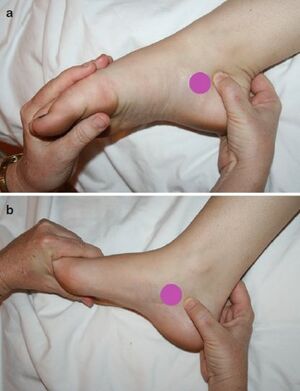Lateral Plantar Nerve Entrapment: Difference between revisions
No edit summary |
No edit summary |
||
| Line 4: | Line 4: | ||
{{Condition | {{Condition | ||
|quality=Partial | |quality=Partial | ||
|pathophysiology=Entrapment of the [[Lateral Plantar Nerve|lateral plantar nerve]] | |||
|clinicalfeatures=Lateral foot pain, numbness, and paraesthesias with weightbearing. Tenderness over the medial calcaneal tubercle. | |clinicalfeatures=Lateral foot pain, numbness, and paraesthesias with weightbearing. Tenderness over the medial calcaneal tubercle. | ||
|tests=Diagnostic injection, ultrasound, MRI, plain films. | |tests=Diagnostic injection, ultrasound, MRI, plain films. | ||
Revision as of 19:41, 16 April 2022
| Lateral Plantar Nerve Entrapment | |
|---|---|
| Pathophysiology | Entrapment of the lateral plantar nerve |
| Clinical Features | Lateral foot pain, numbness, and paraesthesias with weightbearing. Tenderness over the medial calcaneal tubercle. |
| Tests | Diagnostic injection, ultrasound, MRI, plain films. |
Lateral plantar nerve entrapment is a cause of lateral foot pain with weightbearing.
Anatomy
The sciatic nerve runs down the leg and divides into the common peroneal nerve and tibial nerve near the popliteal fossa. At the ankle the tibial nerve is often called the posterior tibial nerve even though it is not a separate branch.
The posterior tibial nerve courses down the foot through the tarsal tunnel and ramifies into the lateral plantar nerve, medial plantar nerve, and the medial calcaneal nerve. There are independent medial and lateral plantar tunnels separated by the medial septum between the medial calcaneus and the deep fascia of the abductor hallucis.[1]
The lateral plantar nerve has several divisions including the clinically relevant Baxter's nerve or the inferior calcaneal nerve.
Aetiology
- Trauma/surgery: failed tarsal tunnel release, harvest of flexor hallucis longus tendon (but medial plantar nerve injury is more likely)
- Lesions: Neurilemmoma, pseudoganglion.
- Foot abnormalities: increased foot pronation, midtarsal joint laxity, forefoot varus, rear foot eversion, pes planus, cavovarus foot, hypertrophy of abductor hallucis from running.[1]
Epidemiology
It is less common than entrapment of its first branch, Baxter's nerve (inferior calcaneal nerve).
Clinical Features

LPN entrapment can occur along with entrapment of other local nerves and so the clinical picture can be tricky.[1]
History
Patients have burning pain, paraesthesias, and numbness involving the lateral side of the sole and lateral toes. Symptoms are typically worse with weight-bearing activities and improve with rest. However symptoms can occur at rest.
Examination
There may be tenderness and paraesthesias when the abductor hallucis is palpated. Tinel's sign may be positive at the proximal and distal tarsal tunnel. Symptoms may be reproduced by tensing the abductor hallucis. Motor deficit is rare.
Plantar Flexion-Inversion Test: The foot is plantar flexed and inverted with pressure applied under the abductor hallucis.
Dorsiflexion-Eversion Test: Pressure over the proximal tarsal tunnel. This compresses the lateral plantar nerve, inferior calcaneal nerve, and medial plantar nerve.
Differential Diagnosis
Investigations
Obtain weight-bearing plain films to assess foot alignment and exclude fractures and osteoarthritis.
MRI may identify denervation changes, masses, and tendon abnormalities.
Treatment
Identify and manage any factors contributing to increased foot pronation: obesity, midtarsal joint laxity, forefoot varus, rear foot eversion, pes planus, cavovarus foot, etc. Orthotics may be helpful. Stretching the plantar fascia and Achilles tendon may reduce stress on the soft tissues. Weight loss and physical therapy to strengthen the intrinsic muscles to reduce hyperpronation.[1]
Injection of the lateral plantar nerve can be diagnostic and therapeutic.
References
- ↑ 1.0 1.1 1.2 1.3 1.4 Brown, Michael N.; Pearce, Beth S.; Vanetti, Thais Khouri; Trescot, Andrea M.; Karl, Helen W. (2016). Trescot, Andrea M. (ed.). "Lateral Plantar Nerve Entrapment" (in English). Cham: Springer International Publishing: 833–844. doi:10.1007/978-3-319-27482-9_74. ISBN 978-3-319-27480-5. Cite journal requires
|journal=(help)
Literature Review
- Reviews from the last 7 years: review articles, free review articles, systematic reviews, meta-analyses, NCBI Bookshelf
- Articles from all years: PubMed search, Google Scholar search.
- TRIP Database: clinical publications about evidence-based medicine.
- Other Wikis: Radiopaedia, Wikipedia Search, Wikipedia I Feel Lucky, Orthobullets,


